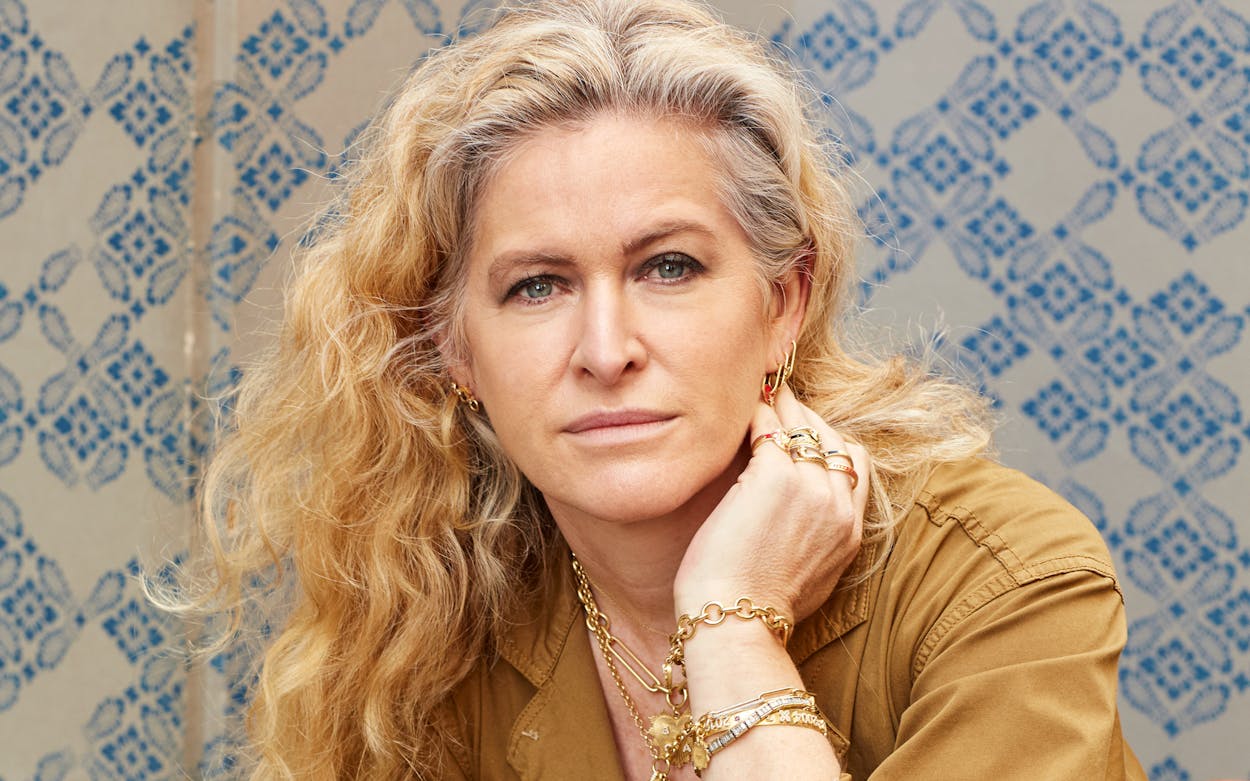When Ben Affleck wanted to design a custom charm necklace for Jennifer Lopez this summer, he turned to Foundrae, the popular fine-jewelry line founded by Brownsville native Beth Bugdaycay and her husband, Murat, in 2015. A cult favorite of notables including Lopez, Gwyneth Paltrow, Dua Lipa, and Vice President Kamala Harris, Foundrae features what it calls “modern heirlooms,” designed to encourage all who wear them to step into their power. The collection’s earrings, rings, bracelets, necklaces, and medallions are made of solid eighteen-karat gold and can be adorned with a wide range of gemstones, Tahitian pearls, or champlevé enamel. With an emphasis on quality craftsmanship, the gold is hand-cast, the enamel is hand-painted, the glass is handblown and hand-carved in Turkey, and special details are hand-engraved in house. We recently caught up with the 49-year-old Bugdaycay, who was the cofounder and former CEO of the fashion line Rebecca Taylor before launching Foundrae and becoming its creative director. She talked about everything from symbolism to self-expression and life during the pandemic.
Texas Monthly: You were raised on the border in Brownsville before moving to New York and working in the fashion industry with designers like Cynthia Rowley and Rebecca Taylor. How did that Texas upbringing shape you as a jewelry designer?
Beth Bugdaycay: Everyone I knew was very sentimental about their jewelry: religious tokens, memorials of past grandmothers, inherited lockets. My sister and I wore matching pressed pennies that bore the Lord’s Prayer. I grew up feeling that jewelry always had a significant personal meaning to the wearer.
TM: Can you share a memory from your childhood in Texas that connects you with your work today?
BB: My dad worked in Matamoros, Mexico, so we would often go across the border. A mainstay of our visits was Salvador’s, a jewelry store that had been in business for over fifty years. The founder was a jeweler who created most of the pieces himself, and when he passed away his daughter continued to run the shop. Many of the pieces that I bought “new” when I was a teenager in the eighties were vintage designs—but never worn—from the fifties and sixties—that were still part of Salvador’s inventory. It was more than a jewelry store; it was family owned and very personal. That was where both my sister and I got our ears pierced.
TM: Whether it is a medallion, a bracelet, or a signet ring, your collection is highly symbolic, with symbols for protection, wholeness, karma, and resilience, to name a few. Why do you think the symbolism behind Foundrae’s pieces has resonated with clients so deeply?
BB: My connection to symbolism has always been there. Symbols help translate our innate desire for evolution and self-expression; many of the symbols we use are thousands of years old. But I think that they are resonating in particular right now because it’s a time of transition, which causes people to reflect more. When in transition, people are more motivated to find what speaks to their heart and what fulfills them—to align better with their life purpose.
TM: For many, wearing Foundrae’s modern heirlooms can help people “suit up” for life’s challenges. Can you elaborate?
BB: The symbols serve as reminders that everything you want is already inside of you. Too often we rush through our days, ticking off our tasks, and we fail to reflect on what is really important to us. The medallions you choose to represent who you are serve as reminders of our purpose and help to inspire our next chapters. I want people to feel connected and empowered, to realize that they aren’t alone in their desire to live a more meaningful and fulfilling life, but also that they are completely empowered to create that for themselves.
TM: What symbols are you loving right now?
BB: For the last year and a half, I’ve been concentrating on symbols in patterns of threes. We shared “Mind Body Soul,” a new symbol of wholeness [a medallion depicting three rays of light and three stages of the moon]. It’s rich in symbolism and inspiration. The beauty of symbols and imagery is that the significance is layered: one image can say what takes a thousand words to describe. The three stages of the moon represent time, but since lunar energy is considered feminine, it also represents three stages of life: maiden, mother, elder. Traditionally, people say “crone” instead of “elder,” but unfortunately crone has so much negativity associated with it. Instead, I want people to recognize that being called an elder is an honorific, a title that we are all aspiring to have and to live up to. It’s a privilege to be an elder but also a responsibility since the elders pass down incredibly valuable information and experience to the next generation. The three paths that lead up to the three stages of the moon are paths of ascension. I see them as representing “mind, body, soul,” which are aspects of our life that we need to push forward in simultaneously in order to achieve wholeness. It can all feel really daunting, and then you see the “elder” moon and remember that the mothers of our mothers have all climbed these paths before us, under much harder conditions.
TM: You recently collaborated with the famed Italian ceramicist Laboratorio Paravicini on a new homeware and tableware collection. How did that come about?
BB: Costanza Paravicini is the founder, and when she found out we had plans to visit Positano, a part of Italy we had never seen before, she immediately recommended that we stay at the hotel that her sister and brother-in-law own, Le Sirenuse. The trip was steeped in history and natural beauty. It was very humbling and reminded me that the world is so large and how much of it I have never seen. That sense of awe translates into new pieces.
- More About:
- Style & Design
- Brownsville






